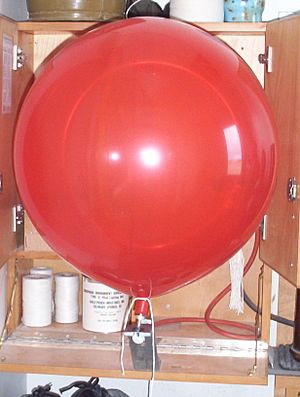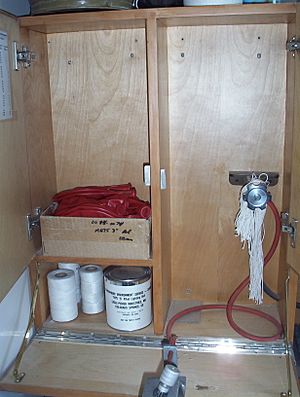Ceiling balloon facts for kids
A ceiling balloon, also known as a pilot balloon or pibal, is a special balloon used by meteorologists. They use it to find out how high the bottom of the clouds are from the ground during the day. Long ago, and sometimes even now, a tool called a theodolite was used to follow the balloon. This helped them figure out how fast and in what direction the winds were blowing high up.
The main idea behind the ceiling balloon is simple. If you know how fast a balloon climbs (its "ascent rate"), you can time how long it takes to disappear into the clouds. This timing helps you calculate the exact height of the cloud base.
Contents
How Do Meteorologists Use Ceiling Balloons?
A ceiling balloon is usually small and red, made of rubber. Before it's blown up, it's about 76 mm (3 inches) wide. When inflated, it becomes about 40 cm (16 inches) across. Once it's ready, the balloon is taken outside and set free.
By timing how long it takes for the balloon to go from being released until it enters a cloud, meteorologists can find the cloud's height. When inflated correctly, the balloon rises at a steady speed of 140 meters per minute (460 feet per minute).
The bottom of clouds is rarely perfectly flat or solid. So, the "ceiling height" isn't when the balloon completely vanishes. Instead, it's when the balloon's color starts to fade as it enters the cloud.
Using Balloons for Low Visibility
These balloons can also measure how far you can see vertically into thick fog or blowing snow. In these cases, the balloon starts to fade as soon as it's released. The vertical visibility is measured when the balloon completely disappears. If the balloon stays visible for a long time even after entering the cloud, observers note this. It's important information for aircraft pilots.
Challenges with Ceiling Balloons
Ceiling balloons are a reliable, safe, and easy way to estimate cloud height. However, they do have some challenges that observers need to know about.
For example, Rain or wet snow can slow the balloon's climb. This might make the cloud height seem higher than it actually is. Strong winds or poor visibility can also make the balloon appear to enter the cloud sooner than it really does.
Since the balloon rises at 140 meters per minute, it takes over five minutes to reach 700 meters (2300 feet). Above this height, it becomes very hard to follow the balloon, even with binoculars. Even a tiny shift in your eyes can make the balloon disappear from sight.
Nighttime Observations
At night, it's too dark to use a ceiling balloon. Instead, a special tool called a ceiling projector is used. During twilight, when it's neither fully day nor night, the ceiling projector might not work well. In these rare cases, a "pibal light" (pilot balloon light) might be used. This is a simple flashlight bulb attached to a battery. The battery is charged by putting it in water for three minutes, then it's tied to the balloon before inflation. These are not used very often today.
Images for kids





